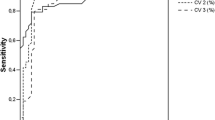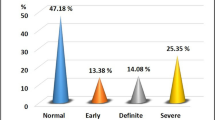Background:
Diabetic autonomic neuropathy (DAN) is a major complication of diabetes. DAN has been shown to be closely related to glycemic control. To contribute significantly to the morbidity and mortality of the disease, and to be indicative of an increased risk of cardiovascular events. Tests asssing the function of the autonomic nervous system, such as the response of heart rate and blood pressure to maneuvers stimulating the autonomic nervous system, including deep breathing. Valsalva maneuver and standing, allowed to detect signs of DAN in adolescents; however, the sensitivity of such tests in revealing an early impairment of the autonomic nervous system proved low. Several studies found heart rate variability (HRV) to be useful in assessing the dysfunction of the autonomic nervous system in diabetic children and adolescents, but only few HRV parameters were evaluated in most of them.
Objective: To study cardiac autonomic nervous system in diabetic children, and to investigate whether the duration of diabetes and the degree of metabolic control are determinants for the development of DAN in children.
Patients and Methods: We analyzed HRV in 50 asymptomatic patients with insulin-dependent diabetes mellitus (IDDM) and 30 healthy children matched for age and sex.
Results: Patiens with a history of diabetes > 8 years showed significant alterations of the autonomic nervous systemm (significant reduction of r-MSSD, pNN50, HF and increase in LF/HF). Conversely, only a reduction in pNN50 was found in patients with a disease duration < 8 years. Furthermore, we also observed significant HRV abnormalities in patients with an impaired metabolic control of diabetes. Compared to controls, patients with glycosylated hemoglobin blood levels (HbA1C) > 8% showed a significant reduction of r-MSSD, pHH50 and total power spectrum, whereas no HRV abnormalities were detected in patients with an HbA1C < 8%.
Conclusions: HRV analysis can detect early subclinical alterations of the autonomic nervous system in asymptomatic patients with IDDM, which seem to consist mainly in a parasympathetic impairment. Autonomic dysfunction is associated both with the duration and an inadequate metabolic control of the disease.
Hintergrund:
Die diabetische Polyneuropathie (DAN) ist eine Hauptkomplikation des Diabetes mellitus. Die DAN zeigt eine enge Beziehung zur Kontrolle der Blutzuckerwerte und trägt signifikant zur Morbidität und Letalität der Erkrankung bei und weist auf eine erhöhte kardiovaskuläre Ereignisrate hin. Die DAN kann bei Erwachsenen mittels spezieller Teste geprüft werden, die die Herzfrequenzänderung und das Blutdruckverhalten untersuchen, wenn Provokationsverfahren zum Beispiel mit Valsalva-Manöver, tiefer Atmung und Stehversuch durchgeführt werden. Die Teste weisen aber eine geringe Sensitivität auf. Die Herzfrequenzvaviabilität (HRV) selbst ist aber ein gutes Verfahren, um eine autonome Dysregulation aufzudecken.
Ziel: Prüfung des autonomen Nervensystems bei Kindern mit Diabetes mellitus in Abhängigkeit von der Dauer und Schwere der gestörten Glucosestoffwechselsituation.
Patienten und Methoden: Bei 50 Patienten mit insulinpfichtigem Diabetes mellitus und 30 gesunden Kindern wurde die HRV geprüft.
Ergebnisse: Patienten mit einer Diabetesdauer über 8 Jahre zeigten eine signifikante Störung des autonomen Nervensystems mit Reduktion der HRV. War die Dauer des Diabetes weniger als 8 Jahre, war nur der Parameter pNN 50 erniedrigt. Eine gestörte HRV wurde nur bei Patienten mit geströter metabolischer Situation gefunden. Bei Patienten mit einem HbA1C Wert > 8% fanden sich erniedrigte Werte für r-MSSD, pNN50 und das Gesamtpowerspektrum im Vergleich zu Kontrollpersonen. Patienten mit HbA1C-Werten unter 8% blieben demgegenüber unauffällig.
Schlussfolgerung: Die HRV-Analyse bei insulinplfichtigen Kindern mit Diabetes mellitus kann genutzt werden, um im subklinischen Bereich eine Störung der autonomen Funktion des Nervensystems zu überprüfen. Im Wesentlichen liegt eine Parasymathikusstörung vor. Die autonome Dysregulation ist korreliert zur Dauer und zum metabolischen Status der Kinder.
Similar content being viewed by others
Author information
Authors and Affiliations
Additional information
Received: December 12, 2001; revision accepted: March 12, 2002
Correspondence Address Massimo Chessa, MD, PhD, Cardiologia Pediatrica, Istituto Policlinico San Donato, Via Morandi, 30, 20097 San Donato Milanese – MI, Italy, Phone (+33/02) 5277-4328, Fax -4459, e-mail: massimo.chessa@lycos.com
Rights and permissions
About this article
Cite this article
Chessa, M., Butera, G., Lanza, G. et al. Role of Heart Rate Variability in the Early Diagnosis of Diabetic Autonomic Neuropathy in Children. Herz 27, 785–790 (2002). https://doi.org/10.1007/s00059-002-2340-4
Issue Date:
DOI: https://doi.org/10.1007/s00059-002-2340-4




